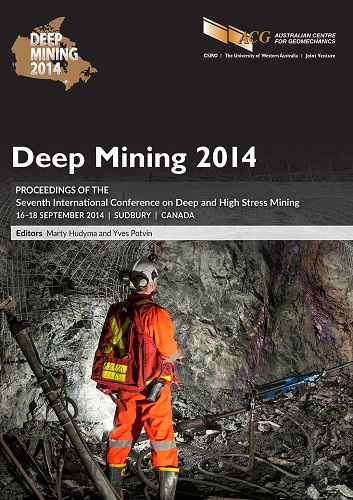Use of cable bolts to reinforce the hanging pillars and improve the ore recovery when stopes are mined using double top sills at Vale’s Copper Cliff Mine

|
Authors: Chinnasane, DR; Knutson, M; Watt, A |
DOI https://doi.org/10.36487/ACG_rep/1410_20_Chinnasane
Cite As:
Chinnasane, DR, Knutson, M & Watt, A 2014, 'Use of cable bolts to reinforce the hanging pillars and improve the ore recovery when stopes are mined using double top sills at Vale’s Copper Cliff Mine', in M Hudyma & Y Potvin (eds), Deep Mining 2014: Proceedings of the Seventh International Conference on Deep and High Stress Mining, Australian Centre for Geomechanics, Perth, pp. 305-314, https://doi.org/10.36487/ACG_rep/1410_20_Chinnasane
Abstract:
There is variability in the geometry of the ore outline, particularly between the footwall (FW) and hanging wall (HW), across the strike length of the various orebodies at Copper Cliff Mine. This geometry creates a requirement to plan transverse sills on one side of the orebody and longitudinal sills on the other side of the orebody on certain levels. In fact, there have been instances where some stopes have been mined using two sills (either transverse or longitudinal) on the top cut. With Vale’s Vertical Retreat Mining Method (VRM), the drilling must be done from both of the top sills using an in-the-hole (ITH) drill. Once the crown part of the stope has been blasted, an undercut pillar or hanging pillar, i.e. a pillar without any support beneath it, is created. Without any additional reinforcement installed into the hanging pillar, there is a high probability that the hanging pillar itself will fail simply by falling into the open stope as a result of the lack of confinement. The sudden failure of a hanging pillar can lead to additional instability as a result of the excessive span across the open stope. The failed material can also lead to operational issues such as a choked drawpoint; in this case, large pieces of ore inhibit mucking in the bottom sill, thus making it difficult to recover all the ore from the stope. Cable bolts have been proven to be one of the most effective reinforcing ground support elements for different applications in underground hard rock mining. Specifically at Copper Cliff Mine, cable bolts are used to pre-support the pillars between the top sills, prior to crown blasting and prior to creating the hanging pillar geometry. Later in the mining cycle, the hanging pillars are further supported by backfill; the fill is placed tight underneath the hanging pillars for long-term, regional support. To date, 10 stopes have been successfully mined in various orebodies at Copper Cliff Mine using cable bolts to support hanging pillars during mining. This paper describes case studies where pillars were undercut, and includes an outline of the methods that were used to mitigate the risks of ground failure. A discussion of the cable bolt design methodology for hanging pillar geometries, and a summary of the benefits achieved in terms of safety, stability and additional ore recovery as also included.
References:
Hutchinson, J & Diederichs, M 1993 ‘An Instrumentation Program for Performance Monitoring of a Cable Bolt Reinforced Rock Mass’, in T Szwedzicki (ed.), Geotechnical Instrumentation and Monitoring in Open Pit and Underground Mining, A.A. Balkema, Rotterdam, pp. 237-244.
Hutchinson, J & Diederichs, M 1996, Cablebolting in Underground Hard Rock Mines, a practical guide and final report of a joint research project through Mining Research Directorate, Canada and Australian Mineral Industries Research Association, viewed 9 August 2014,
Hyett, AJ, Bawden, WF & Reichert, RD 1993, ‘The effect of rock mass confinement on the bond strength of the fully grouted cable bolts’, International Journal of Rock Mechanics Mining Sciences & Geomechanics Abstracts, vol. 29, no. 5, pp. 503-524.
Kaiser, PK, Yazici, S & Nose, J 1992, ‘Effect of stress change on the bond strength of fully grouted cables’, International Journal of Rock Mechanics Mining Sciences & Geomechanics Abstracts, vol. 29, no. 3, pp. 293-306.
© Copyright 2025, Australian Centre for Geomechanics (ACG), The University of Western Australia. All rights reserved.
View copyright/legal information
Please direct any queries or error reports to repository-acg@uwa.edu.au
View copyright/legal information
Please direct any queries or error reports to repository-acg@uwa.edu.au